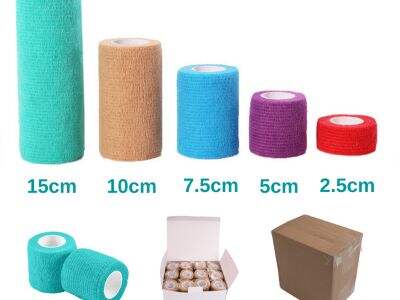Hi there! Did you ever wonder what medical bandages are made of? And today we are going to see together the types of bandage materials.
The Basics: Types of Band-Aids
There are various material components of bandages. Some common types are gauze, cotton, and elastane. Gauze bandages are soft and are air porous — they provide good coverage over wounds. Cotton bandages are absorbent and are soft on the skin. Elastane bandages can also stretch and provide support for injuries. Each type of material has unique features that make it suitable for different types of injuries.
Benefits of Bandage Materials
Gauze bandages are good for wounds because they need to breathe, as they allow air to pass through them. As another challenge, cotton bandages are very good at absorbing liquids, such as blood or pus, and so allow you to keep your wound clean and dry. Elastane bandages are most often used for injuries that require compression to decrease swelling and assist in the healing process. When doctors understand what each material does, they can choose the most appropriate to really heal wounds properly.
Choosing the Right Bandage
There are several factors to consider when choosing a bandage: the type of injury, and the patient requirement. For minor cuts and scrapes, a simple gauze pad can be sufficient to cover the wound and protect it from dirt and germs. For larger injuries, such as sprains or strains, an elastane bandage may be required to provide support and pressure. Selecting the proper bandage promotes faster, better wound healing.
Quality of Bandages: Durability and Breathability
In addition to the benefits, you must also consider how strong and breathable the bandage material is. Gauze bandages are less heavy and allow air to enter them, making them comfortable to wear for an extended period of time. Cotton bandages: Strong and can be used repeatedly without losing their shape. It’s lightweight, elastane bandages stretch to the right pressure on the injury and can be adjusted. This helps doctors know whether or not the band-aid will stick on well enough and provide any necessary support for healing.
Traditional vs. Modern Materials in Bandage Design
Traditional bandage materials, such as gauze and cotton, have been used for decades to cover and protect wounds. These materials are still in use today, however, contemporary bandage materials, such as elastane, offer additional advantages, such as improved support and pressure. By comparing speaking these materials, doctors can make more intelligent choices in choosing which one to use for different wounds.
So, basically, for providing the best care to the patients it is essential to know about the different materials used in medical bandages. This knowledge — of the types of bandage materials, the benefits of those that exist, which factors to consider in selecting the best bandage for healing, how to evaluate their strength and breathability and how to analyse the properties of the old versus new materials — is crucial and will help doctors make better decisions that lead to better healing for patients. So, thank you for joining us all in the Anthrive learning adventure!

 EN
EN
 AR
AR
 BG
BG
 HR
HR
 CS
CS
 DA
DA
 NL
NL
 FI
FI
 FR
FR
 DE
DE
 EL
EL
 IT
IT
 JA
JA
 KO
KO
 NO
NO
 PL
PL
 PT
PT
 RO
RO
 RU
RU
 ES
ES
 SV
SV
 TL
TL
 ID
ID
 LV
LV
 LT
LT
 SR
SR
 SK
SK
 SL
SL
 UK
UK
 HU
HU
 TH
TH
 TR
TR
 MS
MS
 GA
GA
 BE
BE
 IS
IS
 HY
HY
 MN
MN
 MY
MY
 UZ
UZ
